Tillandsia lorentziana
Click thumbnails for full size, scaled to a new window.
Tillandsia lorentziana
Bolivia
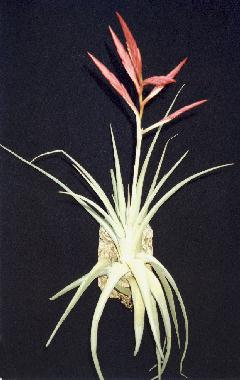
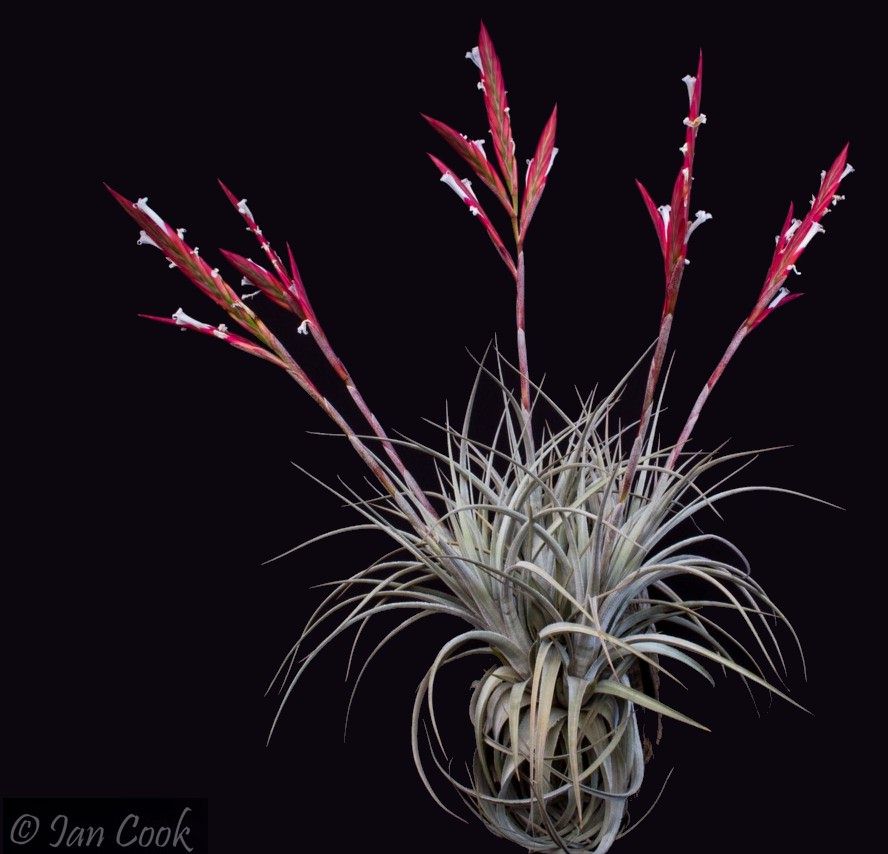
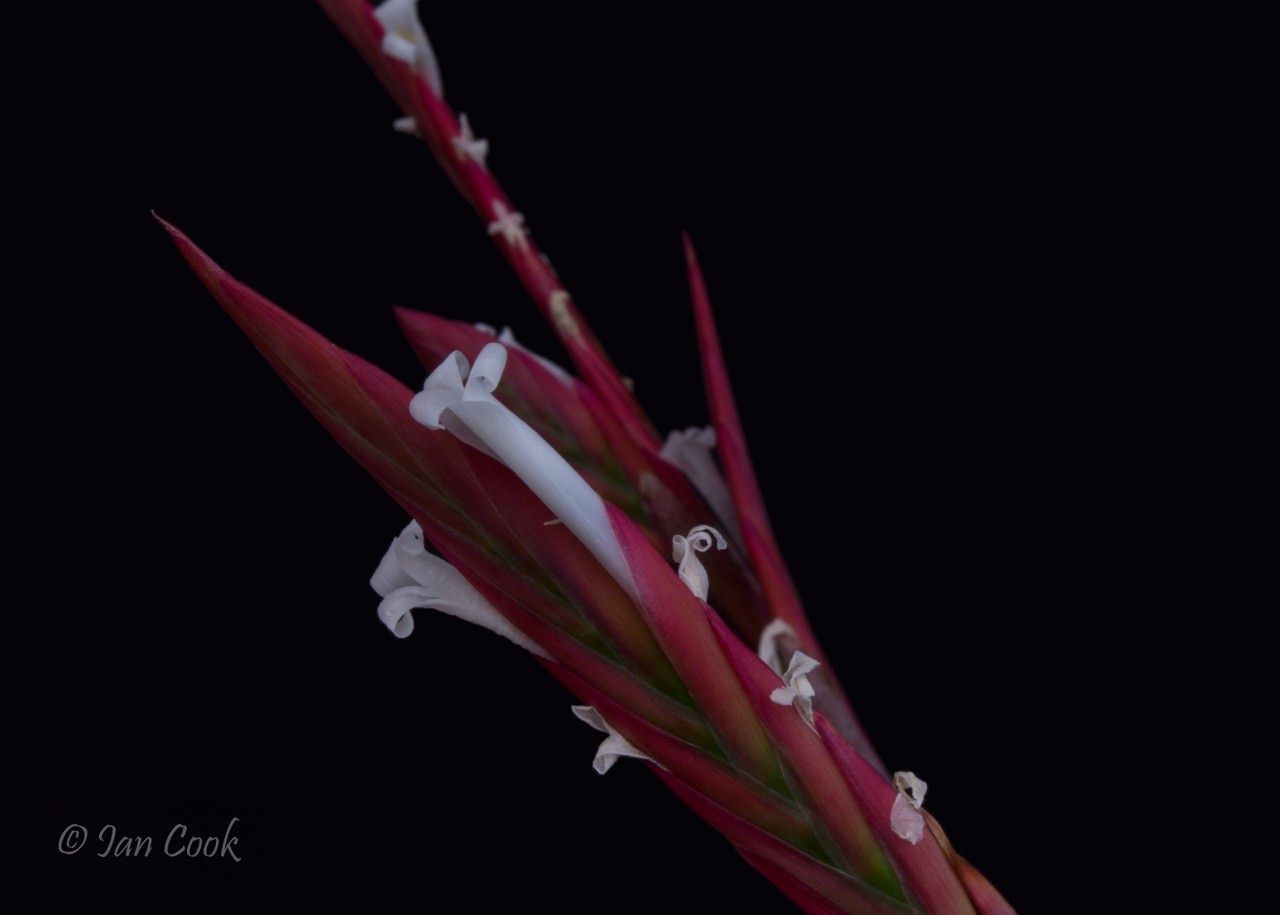
| Ken Woods 10/04. |
Ray Clark 12/16. Photo Ian Cook. |
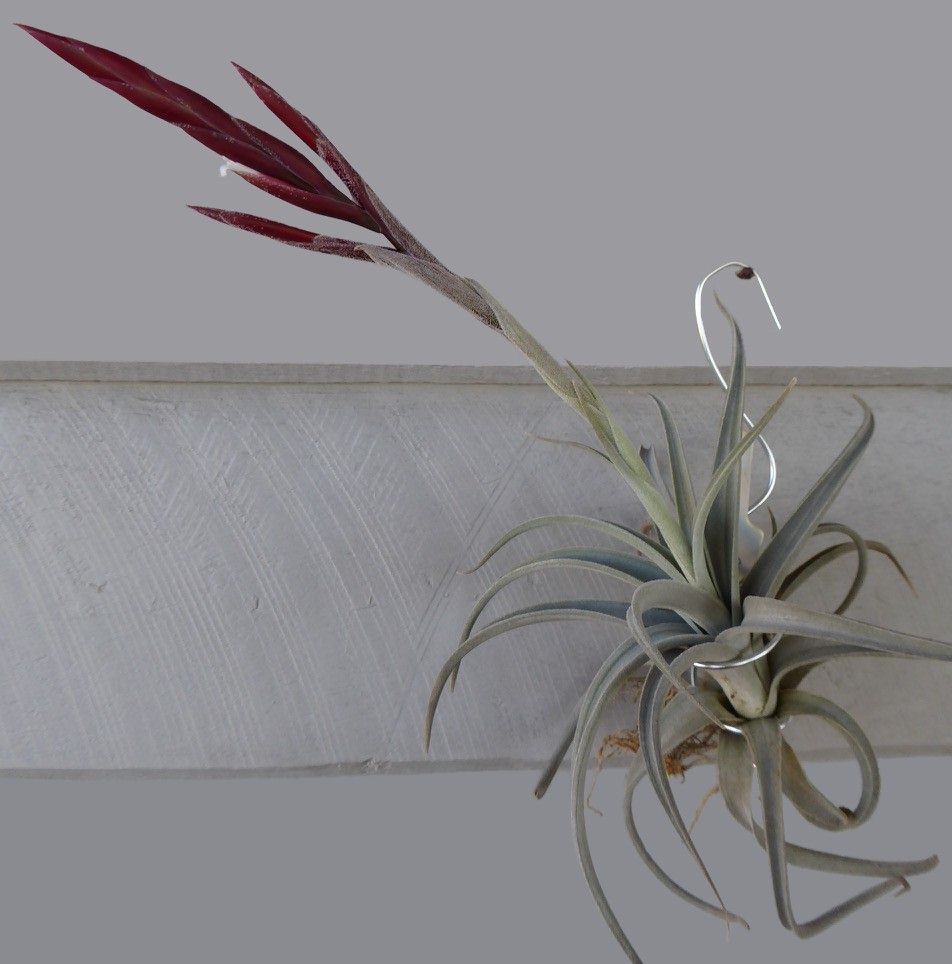
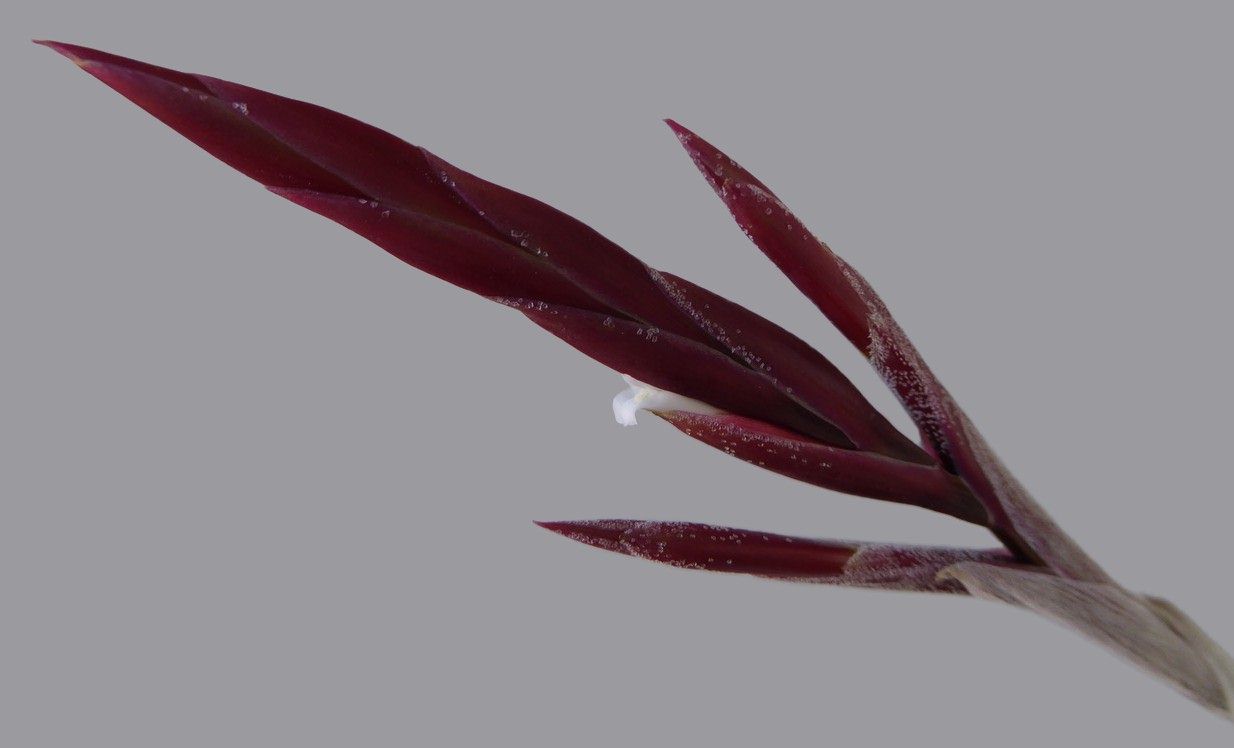
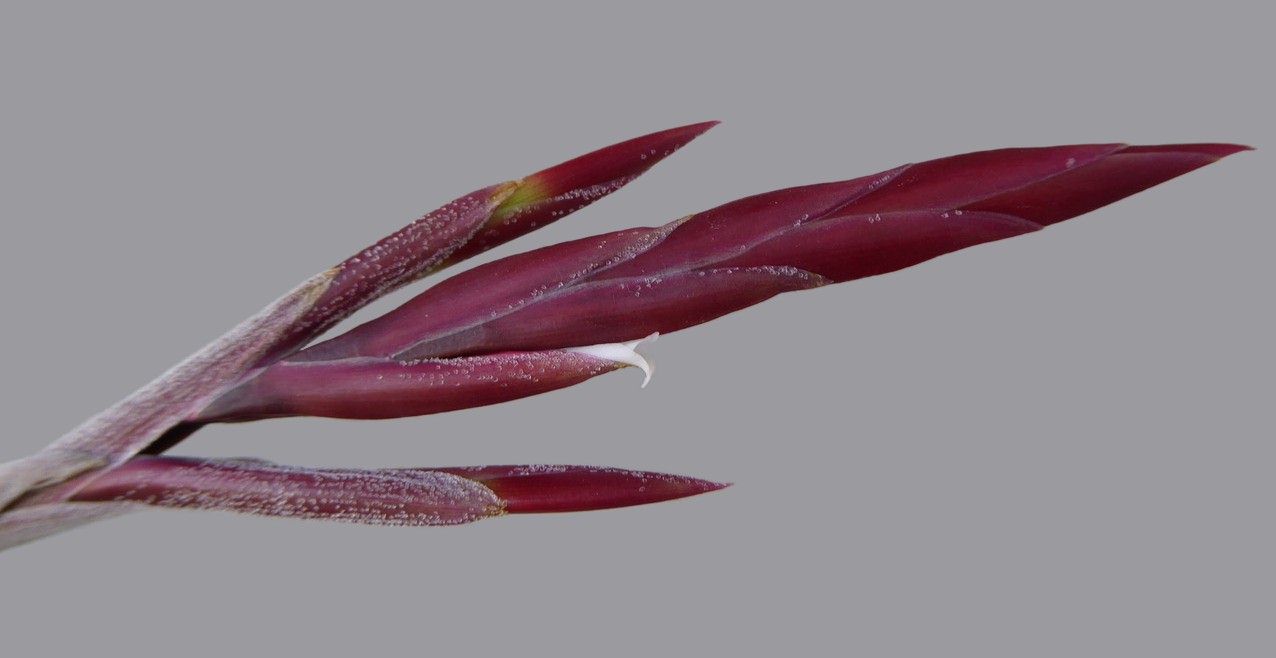 Bruce Dunstan ... "First flowering of this plant for me and when I looked at the disc I realised it doesn’t match the description for T. chiletensis. I’d apreciate your thoughts on what it might be."
Bruce Dunstan ... "First flowering of this plant for me and when I looked at the disc I realised it doesn’t match the description for T. chiletensis. I’d apreciate your thoughts on what it might be."
Derek Butcher ... "That is a blast from the past. T. chiletensis is now lorentziana."
Peter Tristram ... "Derek: The plant Bruce refers to isn’t the blast from the past that Harry Luther suggested could be chiletensis for but is better matched (not perfectly) with lorentziana.
It originated in the US. It usually has a simple or 1 or 2 branched spike with very imbricate, cherry red bracts and has numerous, very slender and scurfy leaves. Bruce’s plant is from me from Germany, as I thought, so has provenance."
Eric Gouda ... "Yes, this is the variable T. lorentziana, T. chiletensis has green bracts and larger flowers but is close to this species (unlike the diagnose by Rauh), see http://bromeliad.nl/species/Tillandsia/chiletensis
I was searching at Chilete, Peru, but did not find them there, but plenty of R. multiflora, T. didisticha, T. pseudofloribunda and some others. Dry area though."
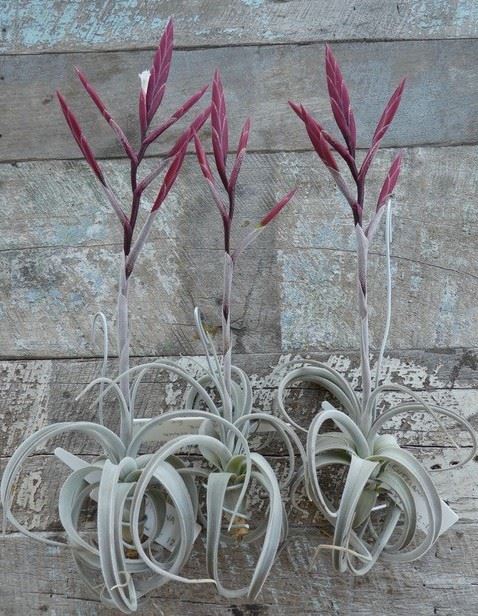
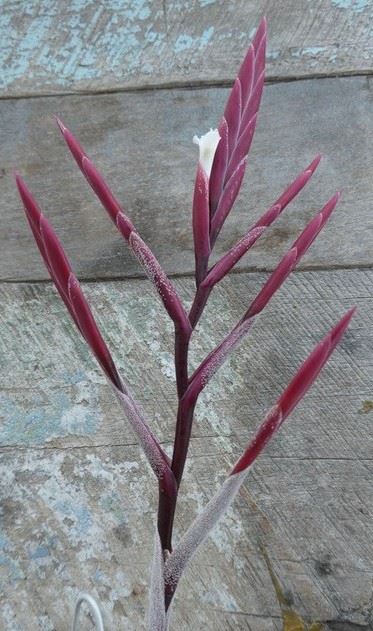
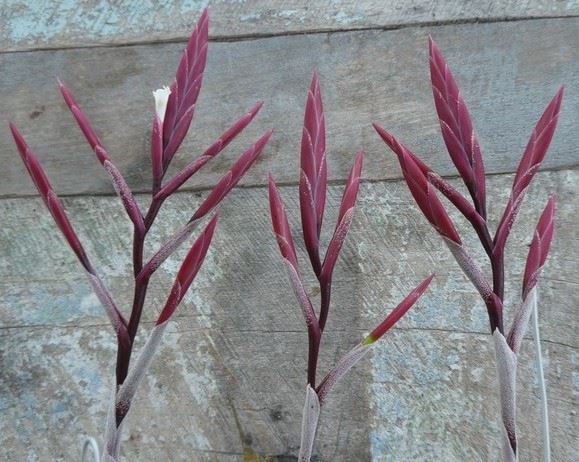 Bruce Dunstan ... "This beautiful white leafed form of T. lorentziana is flowering again. From Peter Tristram who got it from Lotte. Peter or Len do you think this is the one she sourced from Roberto Burle-Marx?. If it is, I’d be very happy, but still I love the cherry red bracts and white foliage. Sadly it sat neglected for many years but has been moved to a better growing position recently when it was divided."
Bruce Dunstan ... "This beautiful white leafed form of T. lorentziana is flowering again. From Peter Tristram who got it from Lotte. Peter or Len do you think this is the one she sourced from Roberto Burle-Marx?. If it is, I’d be very happy, but still I love the cherry red bracts and white foliage. Sadly it sat neglected for many years but has been moved to a better growing position recently when it was divided."
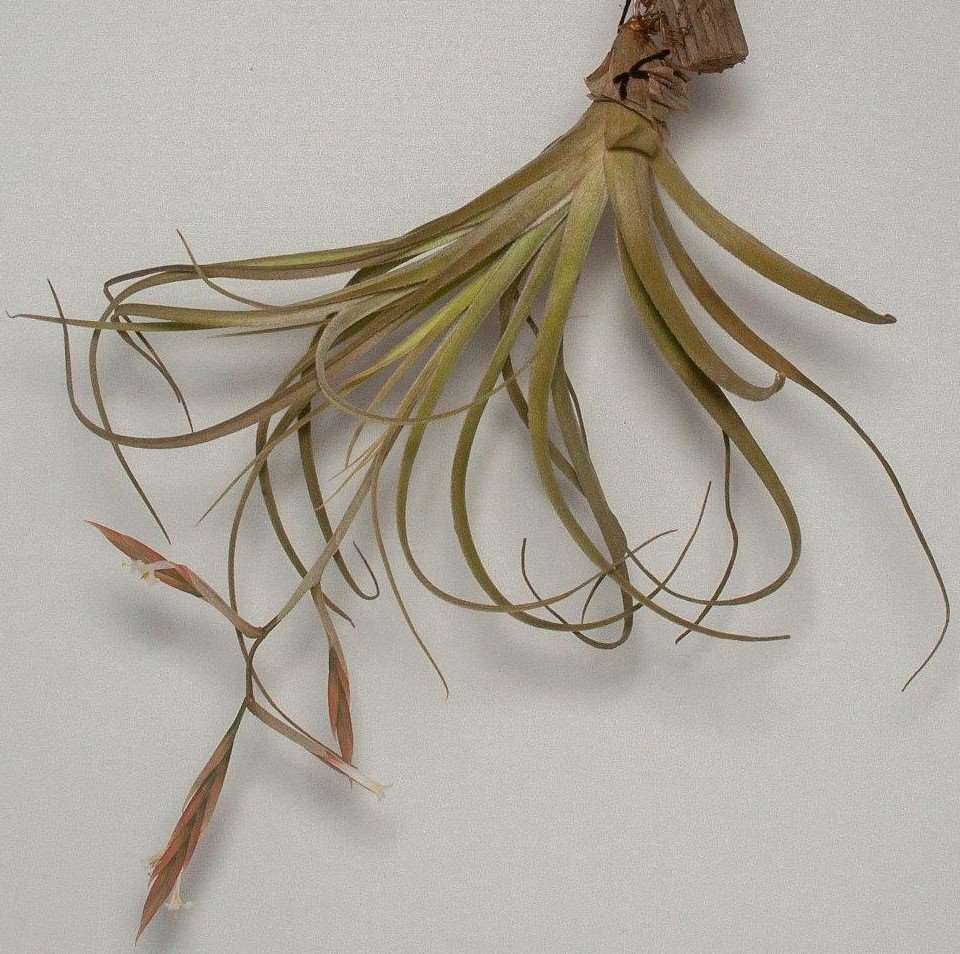
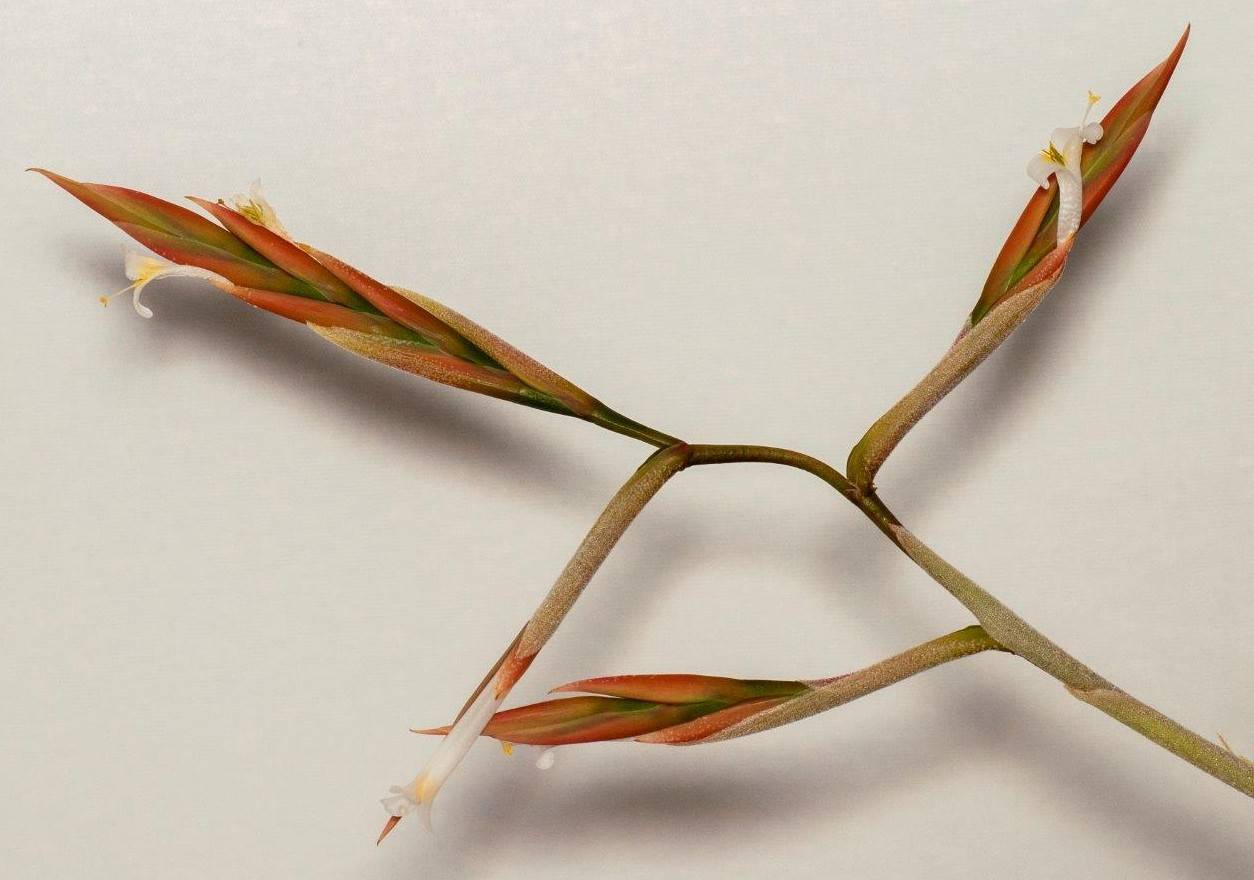
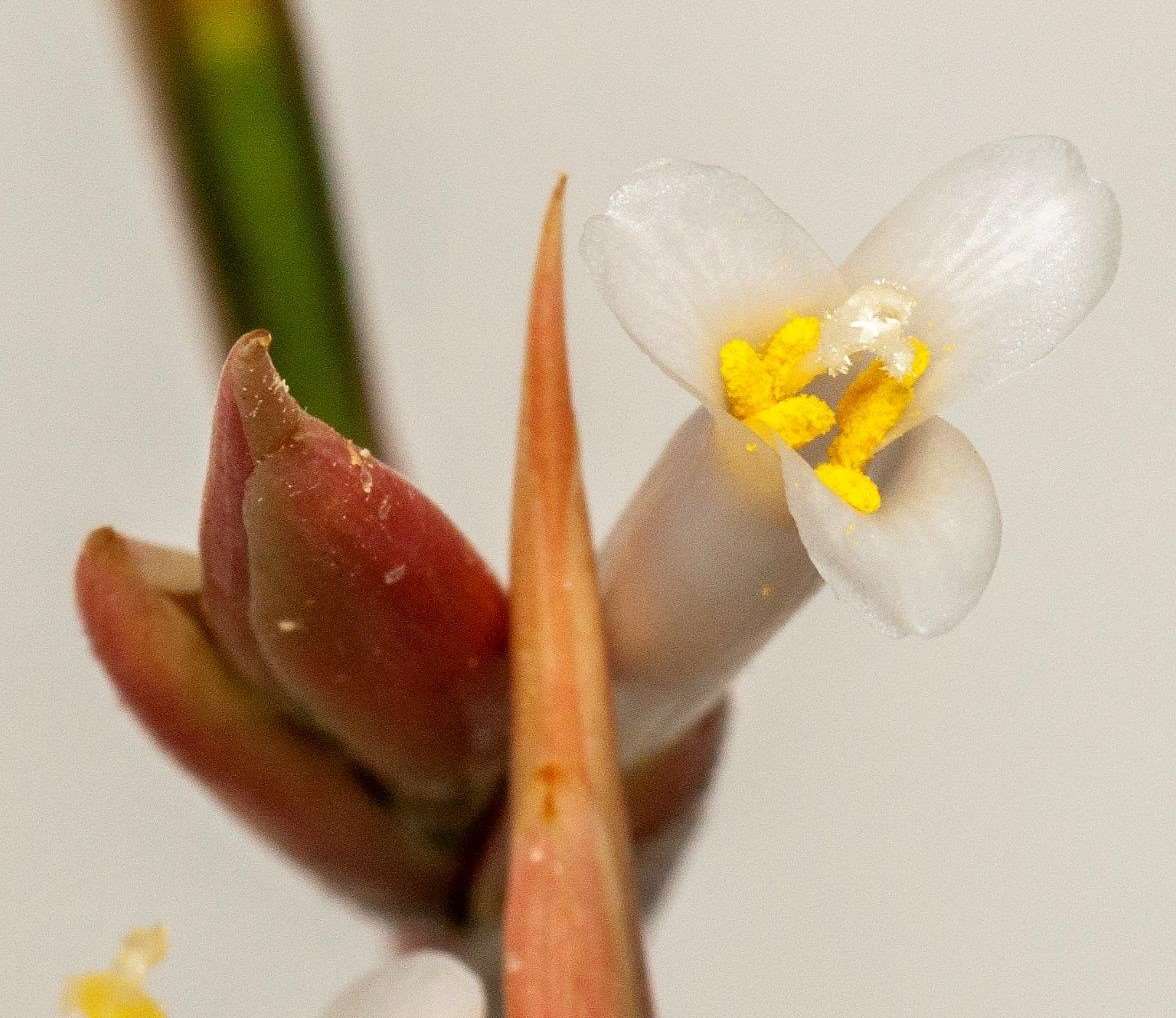
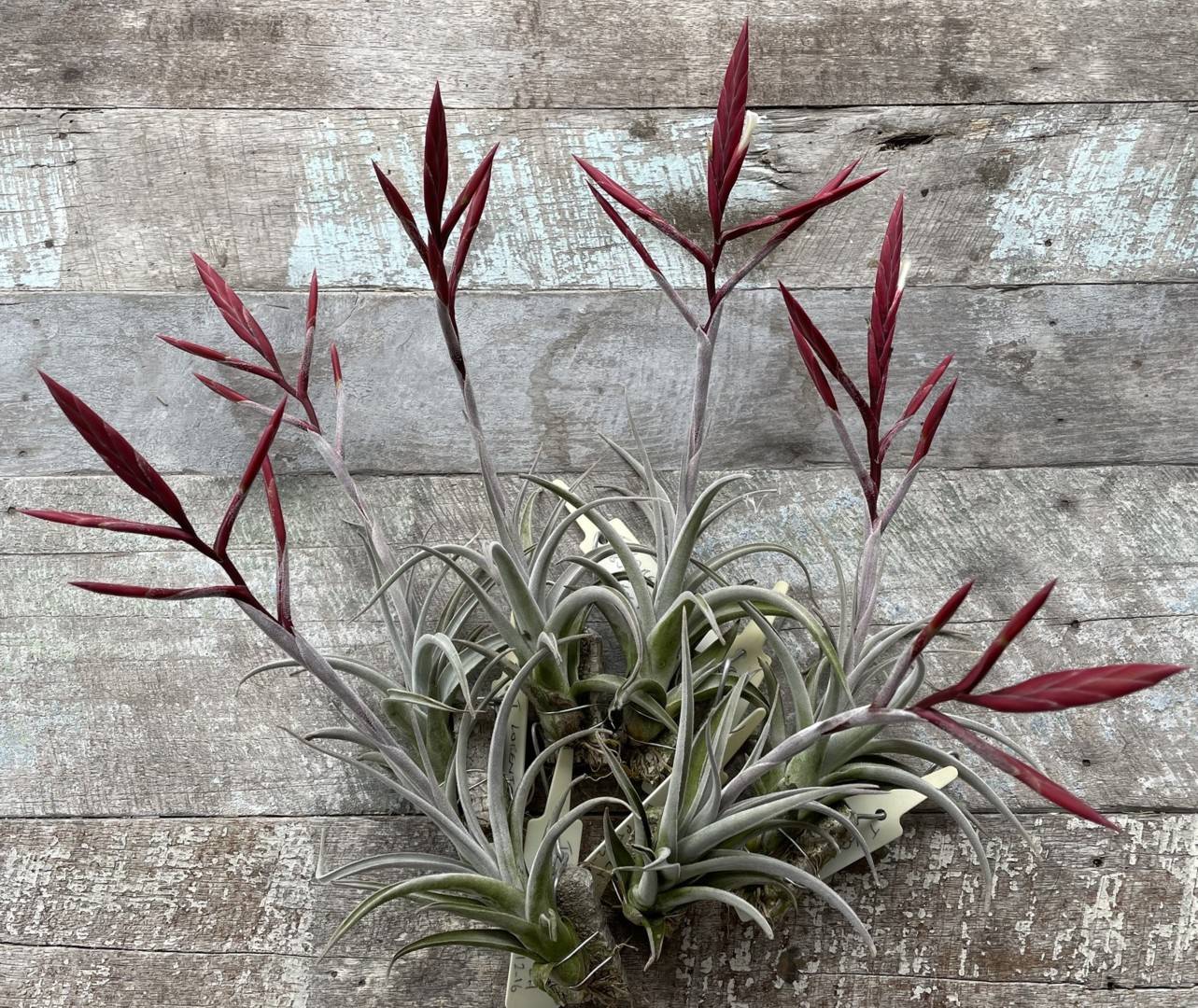
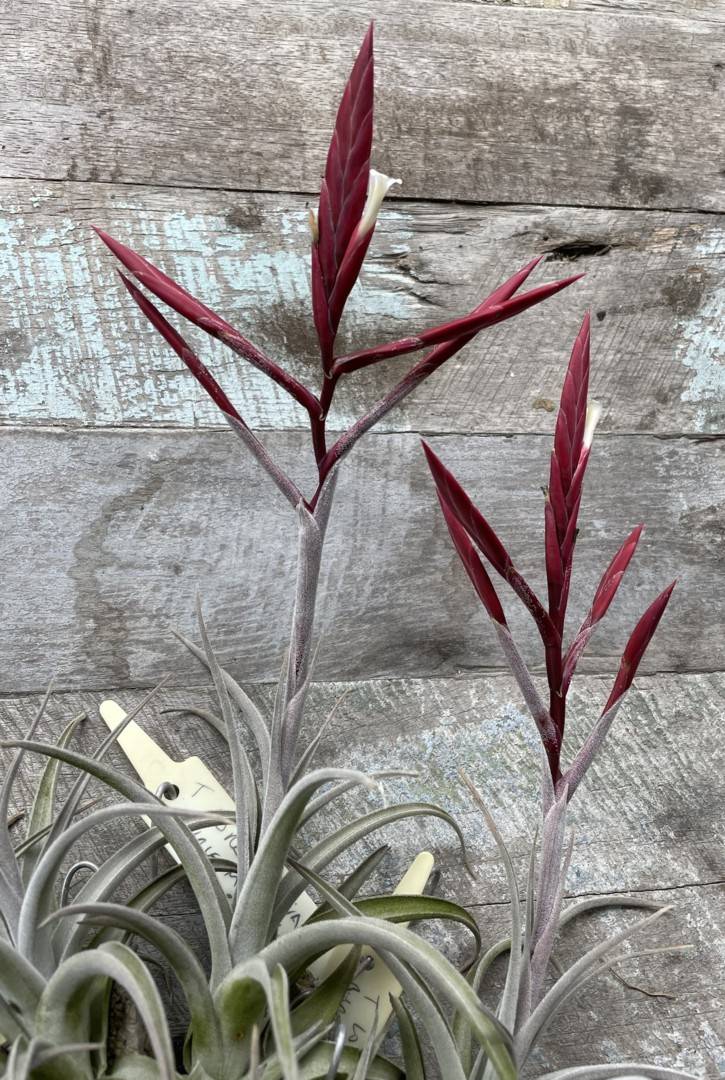
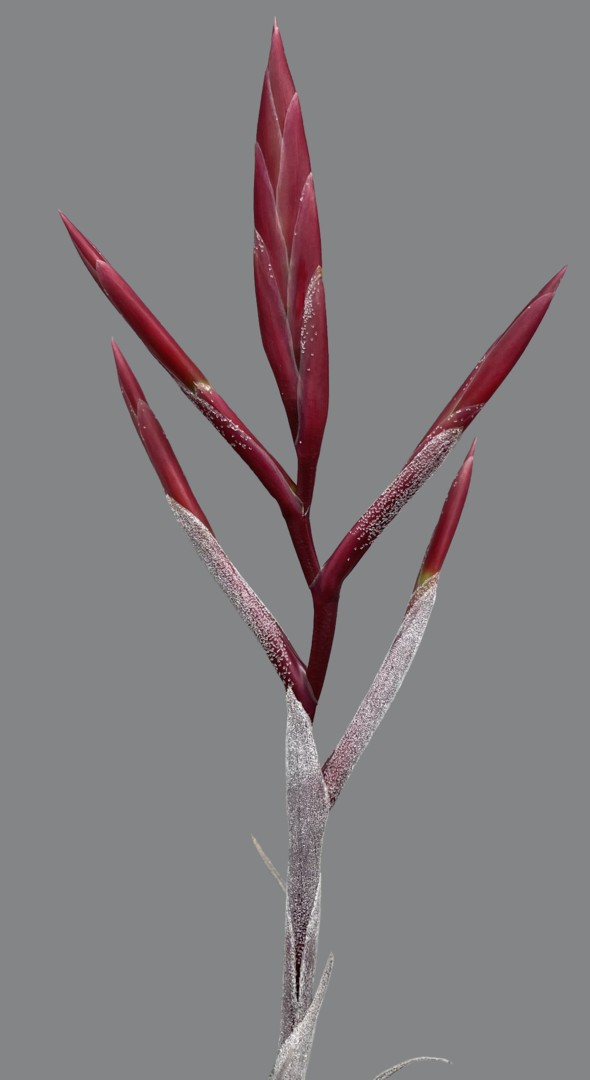
Tillandsia lorentziana forma simplex
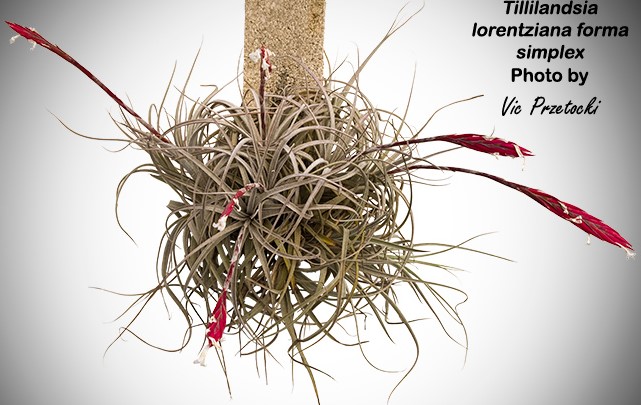
Tillandsia lorentziana Green bracts
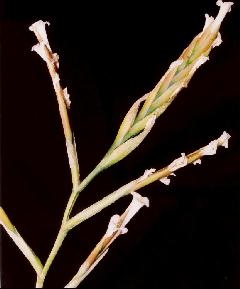
Tillandsia lorentziana Red bracts
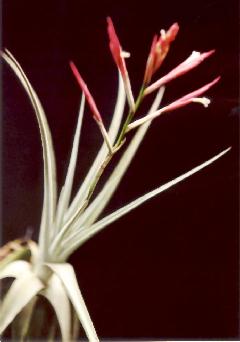
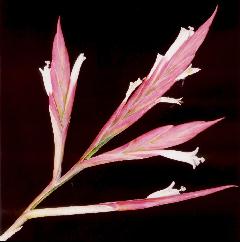
Tillandsia lorentziana aff.
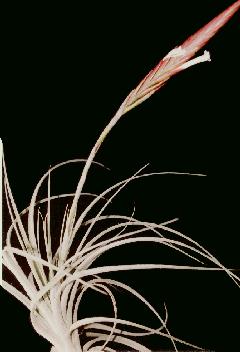
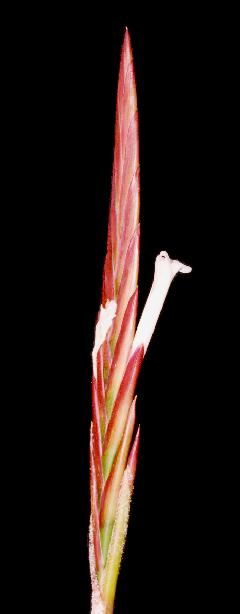
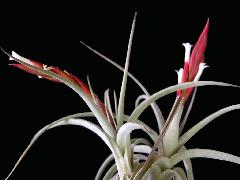
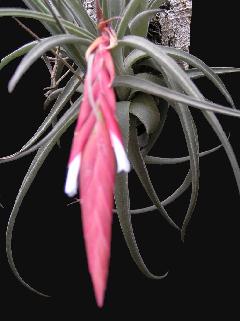
| Ken Woods. Previously listed as cardenasii but probably a lorentziana form. |
Ken Woods. Another form of lorentziana, 12/06. |
Tillandsia lorentziana Giant form
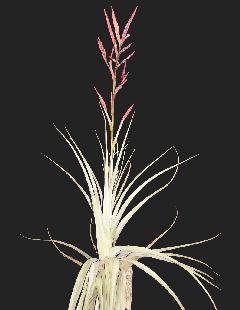
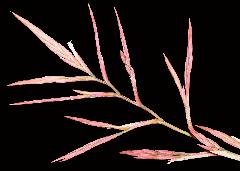
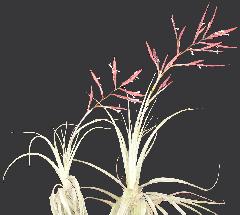
| Ken Woods 11/09. Ex Len Colgan. Leaf 50cm, flower 20cm to 1st branch + 30cm. |
Comparison with normal size. |
Tillandsia lorentziana White form
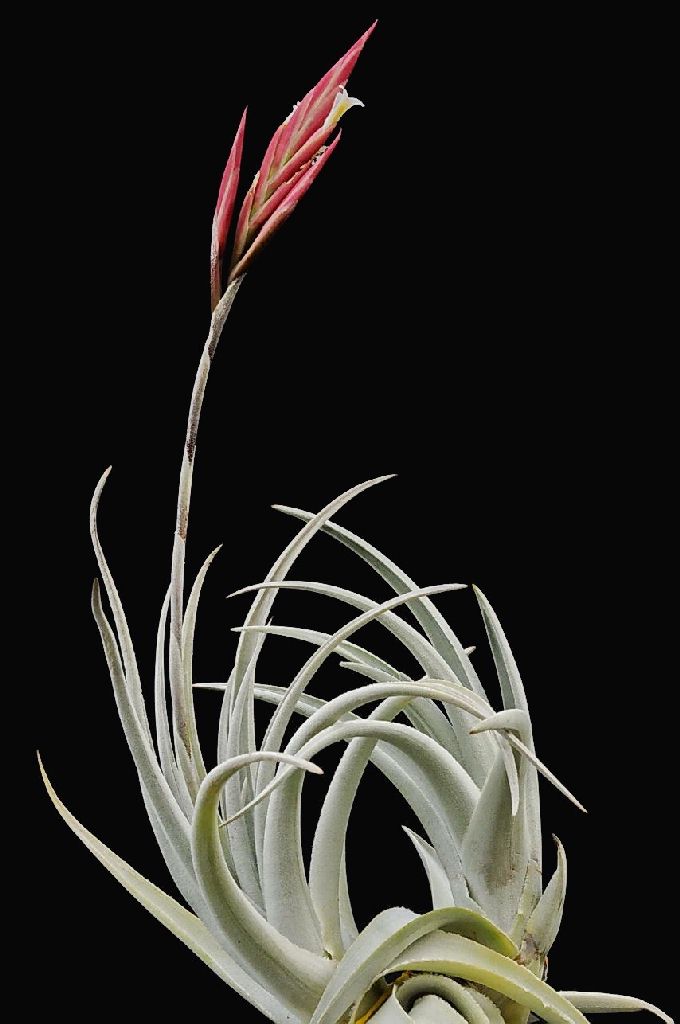
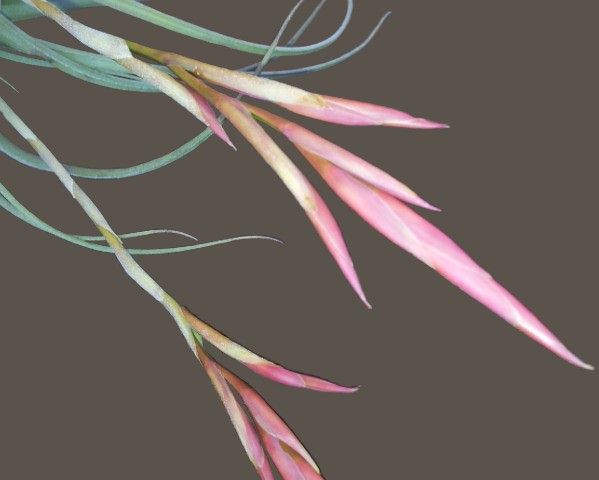
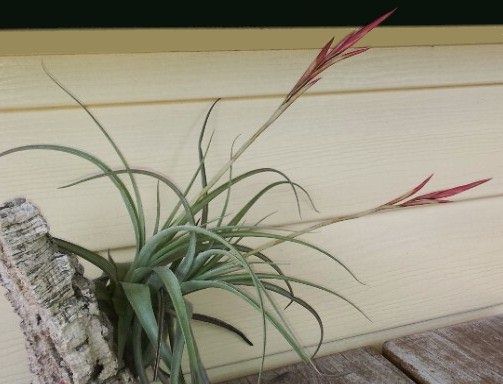
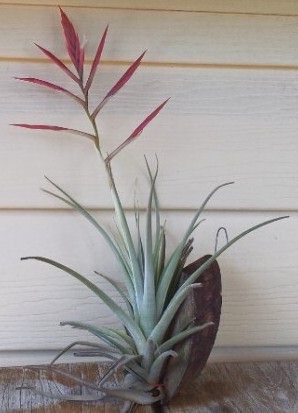
| Peter Tristram. 03/12 |
Mark Supple 12/03, ex-Ross Little form 1. |
Mark Supple 12/03, ex-Len Colgan type 14. |
Peter Tristram 03/12 - "I got this pure white leafed T. lorentziana from Lotte and what a great form. It is quite large, but more compact and xeric looking. Best of all it seems to be a good grower."
"The plant originated from Burle-Marx and to Lotte via Renate, so very likely Brazilian."
Lotte's records - "Sep.97, 164, T. lorentziana, Burle-Marx 1982 - R.Ehlers, Bahia, Bras."
Len Colgan - "Yes. It is my very very best form of T. lorentziana that came from Renate. As the original was given to her by Burle-Marx, she was quite emotional about it. I reckon I have given away two offsets to members over the years. The leaves are pure white, and the inflorescence a bit different to the more common forms from other countries outside Brasil."
Derek Butcher - "Its photo is on the Tillandsia DVD. It seems this clone has whiter leaves (and more virginal) under Adelaide conditions."
Chris Larson - "Even within a small area of Argentina the size & spikes on lorentziana are varied. One that I collected at the type locality of T. peiranoi was small enough to mistake for T. zecheri. Even in culture it is around 6 to 8” in spike."
Tillandsia lorentziana Blue flower
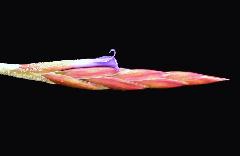
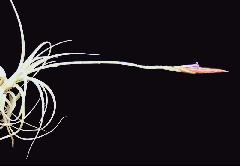
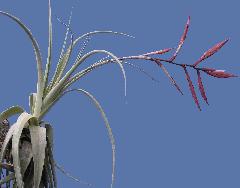
| Ken Woods 12/05. |
Ken Woods 11/09. |
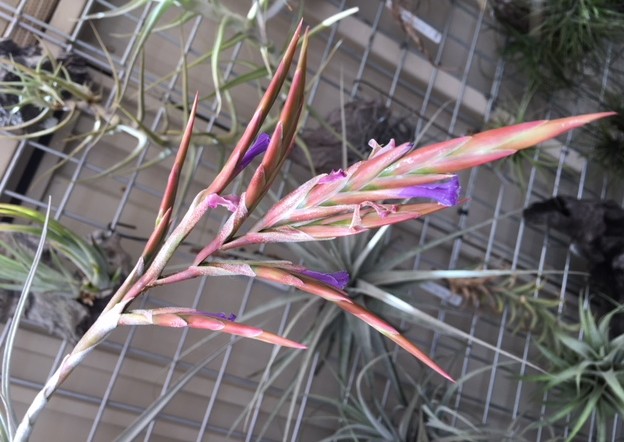
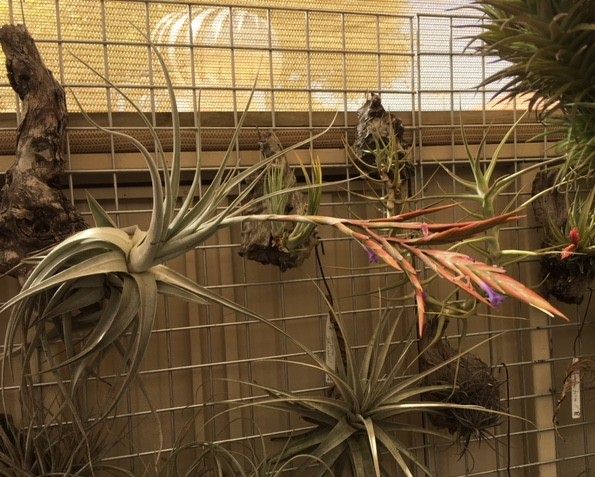
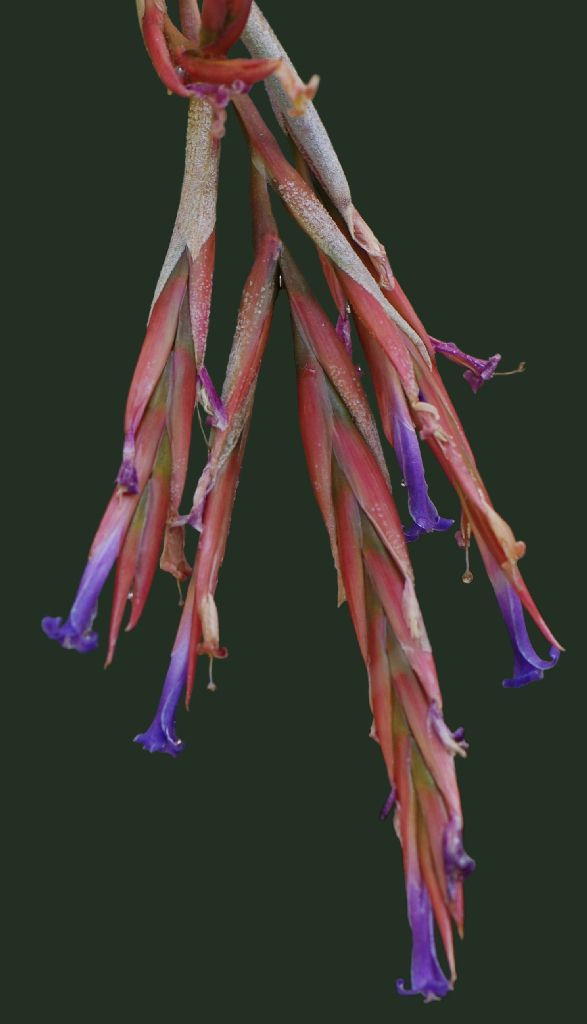
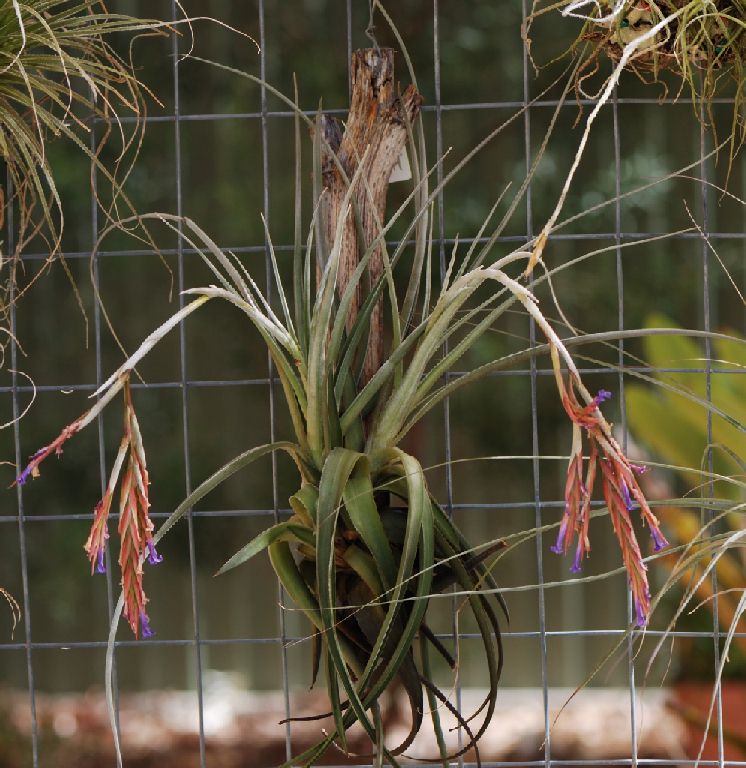
| Ray Clark 01/18 |
George Nieuwenhoven 01/18 |
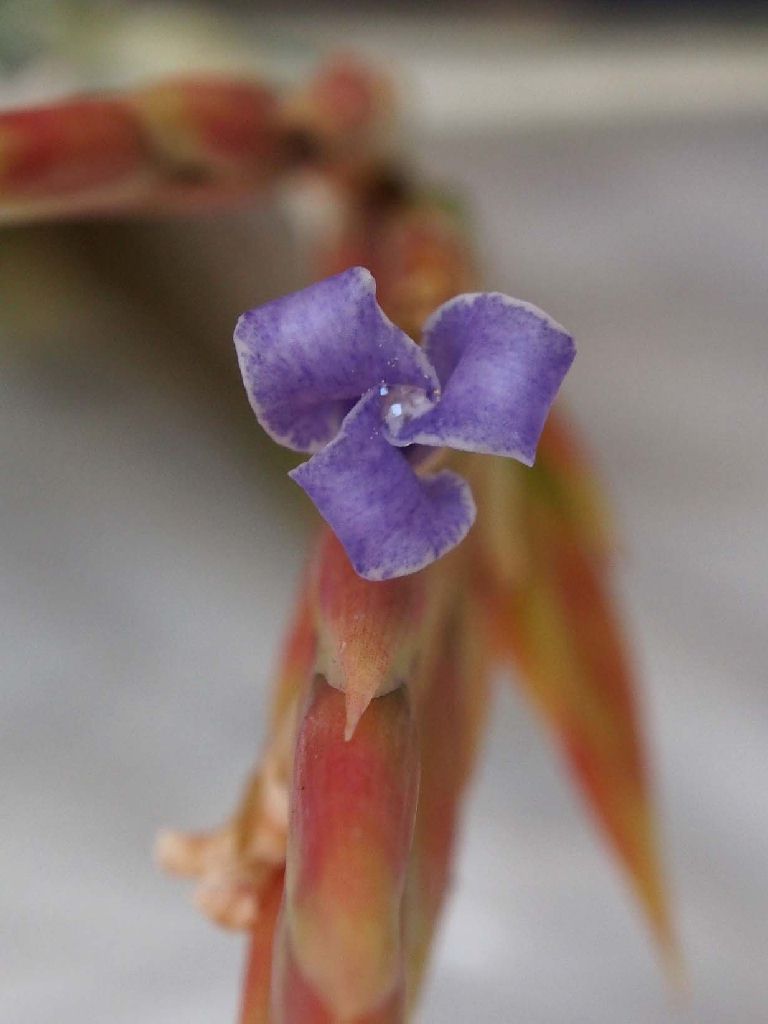
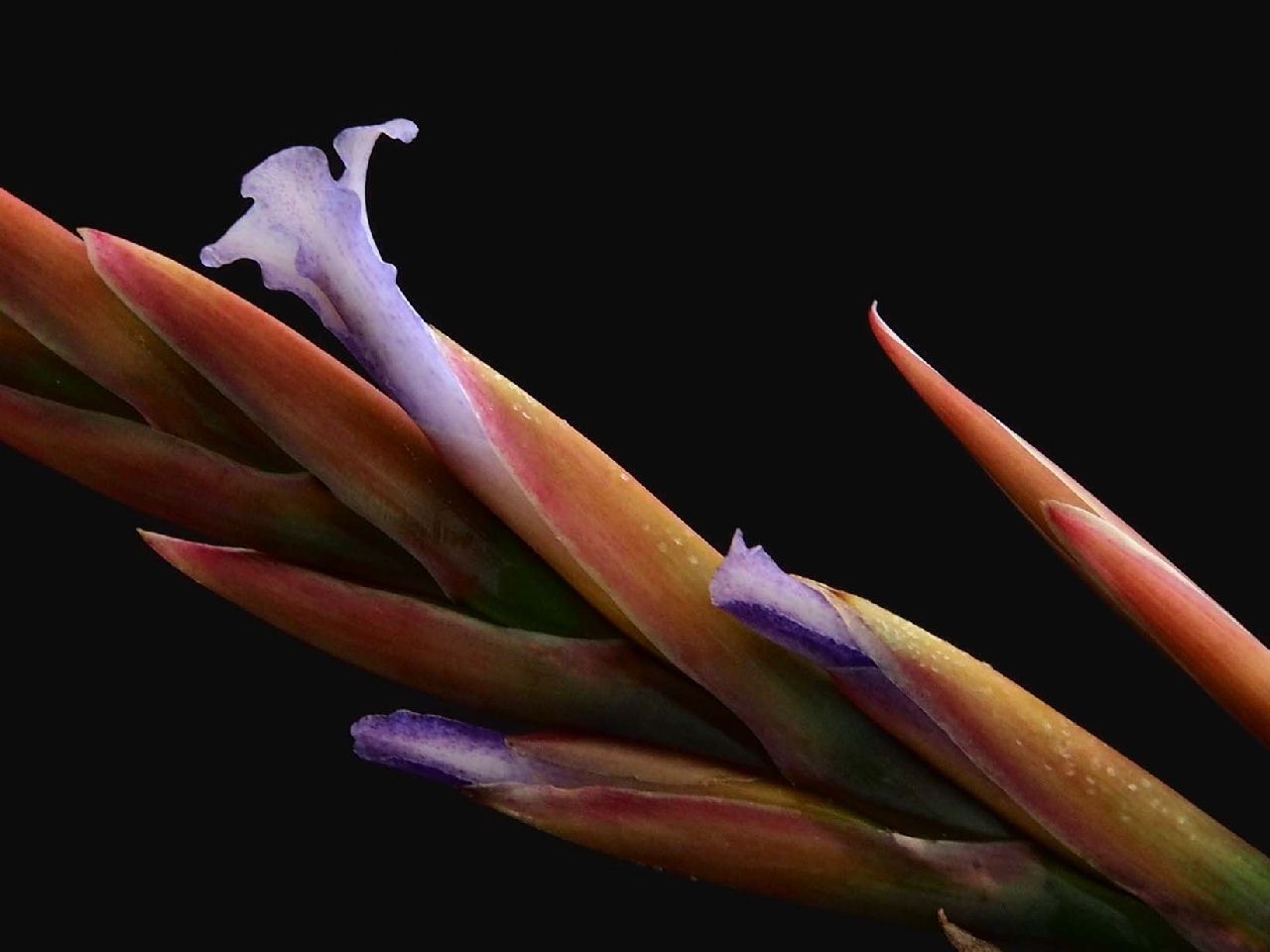
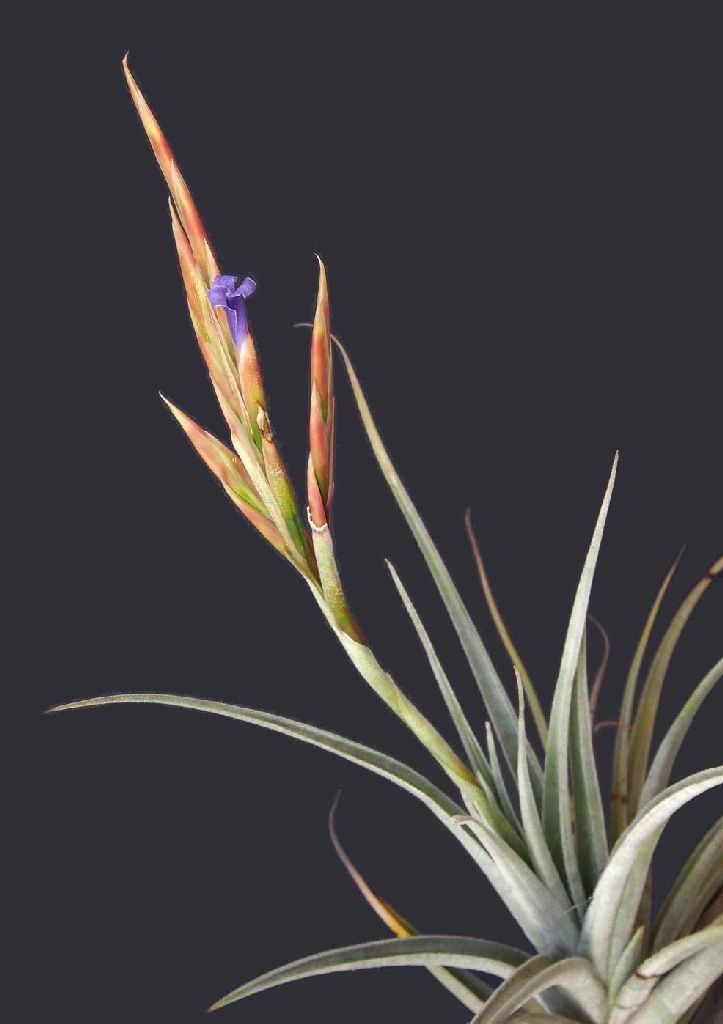
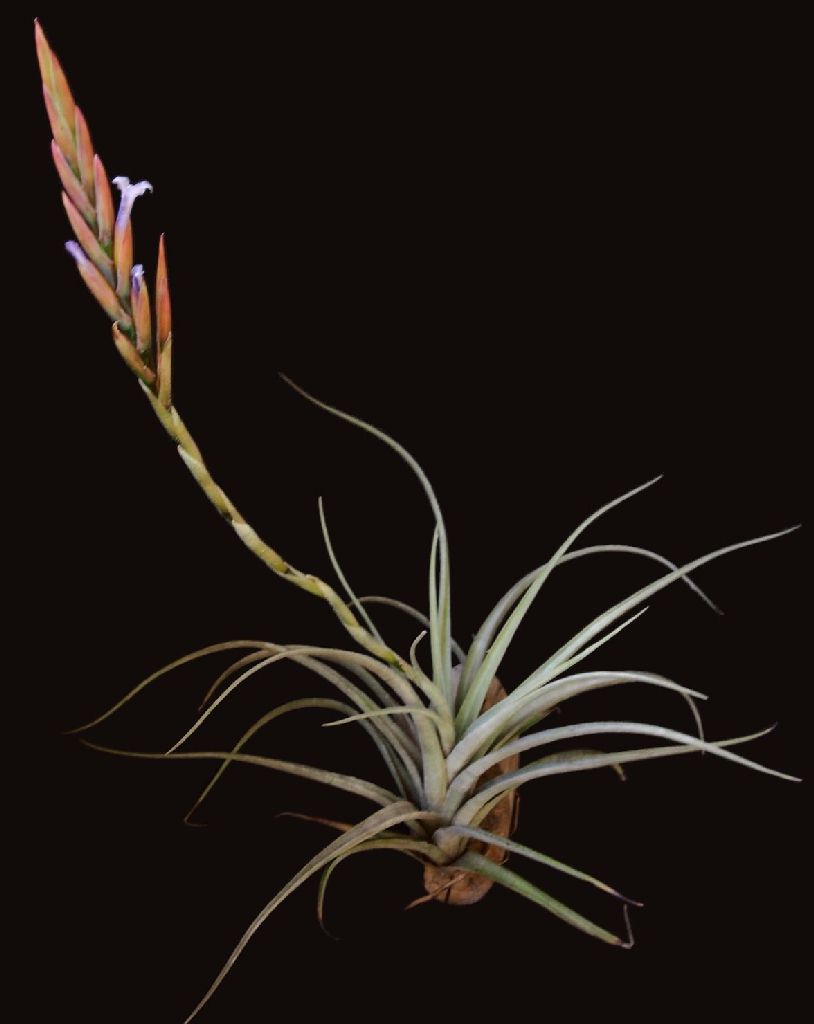
| Julie & Dave Batty 01/18 Purple form ? |
Ray Clark .. "This plant is labeled as lorentziana blue. I’m unsure whether the blue us in reference to the foliage maybe, either way it’s striking and quite hardy."
Bob Hudson .. "T. lorentziana is normally white flowers the Blue on your tag i think will refer to the Blue flowers."
Andrew Flower .. "or it could be a Tillandsia koehresiana ??"
Len Colgan .. "It definitely refers to the flowers.
I can recall visiting nurseries in the USA many years ago, where the only forms of T. lorentziana had white flowers. This is because virtually all of their plants originated from Argentina (or possibly Brazil), where I only ever saw white forms.
However, when on my first collecting expedition in Bolivia, all of the habitats where T. lorentziana was collected yielded blue/violet flowers, except for two locations down south. I was really surprised. Of course, there was still quite a variety amongst the blue/violet forms due to widely separated habitats. The form you have is one of the larger ones.
I also recall re-visiting Bird Rock Tropicals and giving Pam a bunch of seed of a blue/violet form. I do not know if she had success. However, the blue/violet flowered forms are now available in the USA due to subsequent trips around Bolivia by Americans.
Conversely, in Germany there is a lot of the blue/violet forms because of all of the collecting in Bolivia years ago."
Julie & Dave Batty .. "Ray, I also have what looks to be another larger form of lorentziana that had been puzzling me – mainly because the flowers are purple, and also because there is a clear white edge around the petals (similar to cochabambae). This is not evident on the blue flowered type, but they do both have a paler middle section to each petal. Mine didn’t have any label at all so it was good to see your photos and suspect ours both came from the same source."
Derek Butcher .. "Julie: If in doubt, read the following, especially the note by Walter."
George Nieuwenhoven .. "Nice plant and photos Ray. They seem to do well in Adelaide, I have attached two photos of my plant it flowered in 2010 and has done before, it originally came from Maureen Hicks and that would have been at least 25 years ago so it has been around for a while where Maureen got it from is anyones guess but may have been Derek Butcher."
Ray Clark .. "Yes, we all seem to have plants from the same origin, my notes say that mine came from UD and I’ve had it here for about 18 months. Looking at Julie’s plant, yours and mine yes they not only cope with Adelaide weather, they love it!"
Cameron Kettle .. "also grows well, albeit as an infrequent flowerer, in tropical FNQ. Very adaptable / forgiving till."
Note the newly described species Tillandsia uruguayensis which is morphologically very close to T. lorentziana.
As Derek Butcher noted: 27/03/18. "Hot off the press. If you have a T. lorentziana and it can be traced to Uruguay then the description of uruguayensis is a compulsory read! I feel sure that the Europeans like Lotte Hromadnik has Uruguay contacts. You never know."
Tillandsia lorentziana Grisebach, Pl. Lorentz., Gott. 1874.Abh. 19: 271.
Tillandsia lorentzii Andre, Revue Hort. 63: 172. 1891; error for "Iorentziana."
Tillandsia lorentziana var simplex 0. Kuntze, Rev. Gen. 3(2): 304. 1898. Type. Tunari, Cochabamba, Bolivia, Kuntze s n (NY), Oct 1892.
Desc from S&D p801-2
Plant caulescent, flowering 2-7 dm high; stem short and stout but distinct.
Leaves polystichous along the stem, 2-4 dm long;
Sheaths obscure, flat;
Blades very narrowly triangular, long-attenuate, to 20 mm wide, covered with spreading cinereous or brownish scales, often carinate, the inner suberect, the outer reflexed.
Scape erect, slender;
Scape bracts imbricate and usually covering the scape, the lower foliaceous, the upper lanceolate, acute, densely lepidote.
Inflorescence usually bipinnate or simple, lax when compound, usually 12-15 cm long with 4-8 spikes;
Axes glabrous;
Primary bracts like the upper scape-bracts, much shorter than the spikes;
Spikes divergent, straight, oblong-lanceolate, 6 cm long, 15 mm wide, strongly complanate, bracts of the sterile base as large as the floral bracts;
Rhachis flexuous, slender, angled, glabrous.
Floral bracts erect or suberect, imbricate but so narrow as to expose the rhachis, acute, mostly 20-25 mm long, slightly exceeding the sepals, ecarinate, faintly nerved, papyraceous, glabrous or sparsely lepidote;
Pedicels short.
Sepals subfree, oblong, acute, 16-18 mm long, glabrous, the posterior carinate;
Petals 35 mm long, white (or blue see var. simplex above!) , the blades erect, elliptic, obtuse;
Stamens and pistil included, the filaments plicate.
Type. Lorentz 69 (holotype B, F photo 11511; isotype CORD), Las Penas, Arroyo Valley, Cordoba, Argentina, Feb 1871.
DISTRIBUTION. Saxicolous and epiphytic, 700-2600 m alt. Bolivia, Brazil, Paraguay, and Argentina.
BOLIVIA. COCHABAMBA: Tunari, Apr 1892, Kuntze s n (NY); Abra de Sacaba, Mar .1941, Cardenas 2211 (GH); Cerro del Calvario, Quillacolla, Dec 1945, Cardenas 3577 (GH). SANTA CRUZ, Valle Grande: Pampa Grande, 21 Dec 1921, Steinbach 6034-A (F, GH). BRAZIL. GOIAS: Serta da Arruda, Pirineus, 27 Aug 1895, Glaziou 22196 e p (P); Serra dos Pirineus, Pirinopolis, 18 Oct 1956, L. B. Smith & Macedo 4827 (Macedo, US); Corumba de Goias, Cocheiro, 1 Oct 1966, Barroso s n (HB). DISTRITO FEDERAL: Brasilia, 20 Jul 1965, Sucre (RB, US). MATO GROSSO: Urucum, Corumba, 13 May 1941, Foster 1159 (GH). PARANA: Vila Velha, Ponta Grossa, 17 Dec 1903, Dusen 2756 (R); 19 Dec 1903, 2810 (R); 4 Feb 1909, 7624 (S); 25 Jan 1910, 9528 (S); 27 Aug 1939, Foster 412 (GH); Kuhlmann s n (SP); Apr 1953. Paech in Reitz 5680 (HBR); 14 Jan 1965, L. B. Smith, Klein & Hatschbach 14452 (HBR, R, US); 13 Dec 1965, Reitz & Klein 17546 (HBR, US); Rio Silo Joilo, Carambei, Castro, 15 Jan 1965, L. B. Smith, Klein & Hatschbach 14505 (HBR, R, US); 17 Dec 1965, Reitz & Klein 17860 (HBR, US); Paredilo das Araras, Rio Parana, Icaraima, 20 Jan 1967, Hatschbach & Haas 15779 (US). RIO GRANDE DO SUL: Sao Leopoldo, 2 Nov 1934, Rambo s n (LIL, PACA); Dec 1941, Eugenio 2211 (GH); Quarai, Jarau, 10 Jan 1945, Rambo s n (LIL, PACA); Sao Francisco de Assis, A. Seidel 600 (US). PARAGUAY. Paraguari, Aug 1874, Balansa 613 (P); Nov 1882, 4744 (P); Cerro Hu, 15 Dec 1882, Balansa 4743 (P); Itapucu-mi, Rio Paraguay, 19 Sep 1893, Lindman A-2159 (S); Colonia Risso, 25 Oct 1893, Lindman A-2159-B (S); Dec 1916, Rojas 2070 (MVM); San Bernardino, 1916, Rojas s n (MVM); 12743 (S); Serra Pelada, 28 Dec 1928, Jorgensen 3965 (DS); Camachini, Chaco, Dec 1939, Rojas 8713 (GH). ARGENTINA. Jujuy: San Pedro de Jujuy, Schreiter 1755 (MVM); 30 Nov 1925, 5155 (GH); 30 Nov 1926, Venturi 5130 (GH, US); Perico, 19 Jan 1930, Parodi 9040 (BAA). SALTA: Rosario de la Frontera, 7 Jan 1905, Lillo 3913 (GH); Quebrada de Talapampa, Dec 1915, Lillo s n (GH); Alemania, Guachipas, 20 Dec 1929, Venturi 9965 (GH, S, US); 27 Nov 1933, Peirano s n (GH); Coronel Moldes, 15 Feb 1943, Bartlett 19699 (MICH, US). TUCUMAN: Quebrada de Lules, Famailla, 29 Dec 1920, Venturi 1182 (GH, MVM, US); Vipos, Trancas, 3 Dec 1922, Venturi 1984 (US); 19 Aug 1923, Schreiter 6577 (GH, NY); La Carbonera, El Naranjal, Schreiter 799 (GH, MVM). SANTIAGO DEL ESTERO: Ojo de Agua, 1887, Grumbkov in Kurtz5275 (CORD); Sierras de Guasayan, 28 Dec 1942, Arganaraz s n (LIL). FORMOSA: Formosa, Feb 1918, Jorgensen 2804 e p (LIL, US). CHACO. Resistencia, Feb 1935, Schulz 813 (GH); 17 May 1945, Meyer 8833 (AA). LA RIOJA, San Martin: La Diana, Stuckert 17110 (CORD); Gobernador Gordillo: Polco, Chamical, Dec 1895, Kurtz 8922 (CORD); Independencia: Aguadita, 31 Dec 1906, Kurtz 14110 (CORD). CORDOBA: Sierra Chica, 26 Jan 1876, Hieronymus 481 (CORD, US); s d, Lorentz 736 (P); s d, Stuckert 4278 (G); 12 Nov 1905, Kurtz 13064 (CORD); Colanchanga, Sierra de Cordoba, Dec 1875, Hieronymus 350 (B, CORD, GOET); 12 Dec 1890, Kurtz 6959 (CORD); Dique, Dec 1891, Kuntze s n (NY); Dec 1901, Mina Clavero, San Alberto, Stuckert l1297 (CORD, G); Calera, Colon, 31 Dec 1902, Stuckert 12420 (CORD, G); Villa Garcia, Tanti, Punilla, 16 Dec 1909, Stuckert 20477 (CORD); Dean Funes, 30 Nov 1916, Sanzin 1288 (MVM); Capilla del Monte, Valle de Punilla, Jan 1917, Hosseus 54 (CORD); Alta Gracia, Santa Maria, 30 Jan 1944, Pierotti s n (AA, US). CORCERIENTES: Estancia Santa Teresa, Mburucuya, 22 Nov 1949, Schwarz 8846 (LIL); 1 Aug 1951 , Pedersen 482 (C, US).
forma simplex 0. Kuntze. Revis. Gen. III, 2. (1898) 304; Castell. in Anal. Mus. Nac. Hist. Nat. Buenos Aires XXXVI. (1931) 374. Treated by S&D as a synonym of T. lorentziana.
Detail from Mez 1935 - A typo differt spica simplici si composita tunc pannicula depauperata; petalis lilacinis staturaque minore
Bolivia (0.Kuntze). Argentina: San Luis, San Francisco, Quebrada del Palmar (Castellanos n. 25/612), Quebrada de Ramos (id. n. 25/513), Quebrada del Rio Quines (id. n. 25/611); Cordoba, Dept. San Javier (Hauman n. 1600), Capilla del monte, Los Paredones (Castellanos n. 1594).
Note from Walter Till 15 Apl 1997
I know the problem with the blue petalled Tillandsia lorentziana. Confusion is even stronger when you take into consideration that T. cardenasii (incl. the dwarf form T. pseudocardenasii) is widespread in Central Bolivia and is closely related to T. lorentziana. As the blue petalled T. lorentziana tend to have simple inflorescences I would not exclude that they represent natural hybrids of the two aforementioned species.
However, extensive field studies are needed to interpret this alliance correctly.
The following was referred to in Mez 1935 under T. lorentziana but he clearly mixed plants especially when he treated T. rusbyi as a synonym.
No reference in S&D. After consultation decided to treat this as Vriesea aff. lubbersii
Tillandsia lorentziana Grisebach by L. Wittmack in Gartenflora XL 313, t. 1349, (1891)
Translated by Butcher
Sect. Platystachys. Leaves from a longish base narrowing to linear, acuminate, rolled inwards, bent over, shorter than the shaft, bran-like scales, scales,( hairy) densely prominent, greyish-white. Panicle drawn together, formed by several spikes, the individual spikes with 3-5 flowers, prominent, alternate, somewhat apart from each other, rather equally long. Floral bract of a single flower (shiny scarlet red), imbricate, distichous, smooth, folded, longish, acuminate, nerved striped, a little exceeding the sepal, 3-4 times longer than the internodes. Sepals 1˝ times longer than the claw of the petal, acuminate, petals with threadlike claw and spatulate-lanceolate (white) blade, that is half as long as the claw. anther prominent, style even further extended, stigma blunt, ciliate.
Compared with T. balbisiana Schult, it is distinguished at first glance by the scales on the leaves and the lower bracts, and spreading from T. pruinosa Sw.
Stem 1 foot high. Leaves 4-7 inches long, base 8-10 lines wide, gradually narrowing, about the middle becoming narrow, gradually merging into the scape bracts on the stem, sheath-like, about 1˝ in long, spike 3-2 in. long, floral bract 1 in. Sepals 10/12 inch, petals 1 8/12 inch long.
Cordoba. At dry rocks in the valley of the river Auroyo near Las Penas. Lorentz n. 803)
Preceding this is Grisebach’s almost verbatim translation of the description in his “Plantae Lorentziae”, treatise of the Gottinger Society of the Sciences, XIX, 1874, p 271 (refer. Baker, Handbook Brom. 182).
"
"The plant first flowered with Mr. Jacob Makoy in Luttich 1880, and in the year 1890 in the Orchid - Garden of the Garden-Inspector J C F Bouche in Endenich near Bonn, who directly introduced the plant. Our illustration is produced from an illustration of the original plant painted by Mr. Inspector Bouche, that he had determined and sent over to us. We have not seen the plant itself, only one leaf and an individual flower. Mr. J G Baker in Kew, to whom we sent the illustration, however also thinks that it is probably T. lorentziana. Hopefully we will later see another with a richly branched panicle: in the Grisebach collection there is such a plant and also has a single spike with more flowers. Mr. Inspector Bouche wrote the following to us about the plant:
Two years ago, I travelled through Paraguay with a friend, Mr. Schantzer, where different Bromeliaceae and orchids often repeatedly, grow, a Bromeliaceae species attracted my attention particularly through its odd habit, and which I had not yet noticed in known Bromeliaceae collections. Immediately near falls in relatively low growth we found an unusual prominent plant, strong bulblike appearance below, above the roots there is a tuft of leaves. The same becomes formed at the trunk by wide leaf bases, which provide the plant with a large natural reservoir. We are privileged to have imported examples of it here with one purely epiphytic form.
After about a year in cultivation with the plant in fibrous orchid-mix and swamp-moss, (I have cultivated similar plants of this type with good success for years), the same developed an about 35cm high flower stem from the centre, the lower part with green scape bracts, and in the upper part a shiny cinnabar red colour.
They have the same colour as the flower stem and its additional branches with surrounding bracts. The not large flowers are pure white and stands in effective contrast with the scarlet bracts so that the plant at flowering time is one much admired ornament of my Bromeliad collection. The illustration added to the text here was prepared from a watercolour drawing from my garden, shows however, as is abundantly clear with pictorial representations of flowers, that unfortunately are not those shining natural colour tones of the plant.
Through artificial fertilization of the flowers I succeeded in getting viable seed from T. lorentziana, that were sowed about two weeks ago. I hope that I will receive a large number of young plants soon. It multiplies very easily also through side offsets (babies), which this Bromeliad produces to 3-4 cuttings, and accordingly I already have 8 young plants, that each sells at 20 Mks per piece.
Figure-information (gf40-313): a Floral bract with dry flower, b. Floral bract, c Sepal, d. Flower, e Petal, f. upper part of filaments, g. Ovary
Updated 20/06/25








































